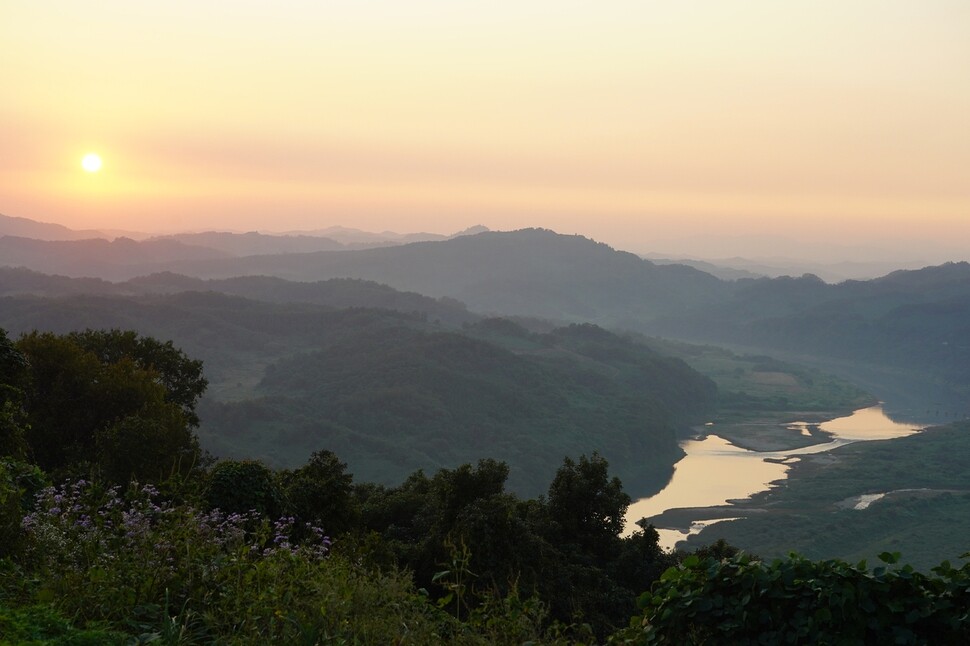hankyoreh
Links to other country sites 다른 나라 사이트 링크
Local governments gear up to utilize and conserve UNESCO biosphere reserves in DMZ

After parts of the demilitarized zone (DMZ) in Yeoncheon County in Gyeonggi Province and Cheorwon, Hwacheon, Yanggu, Inje, and Goseong Counties in Gangwon Province were registered as UNESCO biosphere reserves this past June, the local governments are rolling up their sleeves to utilize and conserve the areas in question.
Yeoncheon County announced on Oct. 4 that it’s designating 2020 as the “Year of Visiting Yeoncheon,” with the goal of attracting 10 million tourists. “We will seize this as an opportunity for making the nation aware of the outstanding natural and ecological system around the DMZ in Yeoncheon,” the county said.
The Yeoncheon Imjin River Biosphere Reserve occupies 584.12 square kilometers (including a core area of 63.69 square kilometers, a buffer zone of 208.1 square kilometers, and a cooperative area of 312.33 square kilometers), which represents the entire county of Yeoncheon County, except for the DMZ itself.
The core region is a forest genetic resource reserve area and cultural heritage reserve area centering on the Imjin River, with a buffer zone including an area of 100m on either side of the Imjin and Hantan waterways and the surrounding national forest preserve. Cooperation zones including residential areas and farmland where ongoing management and usage of the core and buffer regions.
Following the registration of the Imjin River Biosphere Reserve, Yeoncheon is awaiting registration of Hantan River Geopark next April. If Gyeonggi Province’s attempted registration of the DMZ as World Heritage comes to pass, Yeoncheon will join Jeju Province in achieving South Korea’s second-ever “hat trick” of UNESCO crowns. Geoparks are regions that require protection for their geologically outstanding value; a total of 140 are currently designated in 40 countries.
Gangwon Province, whose Gangwon Eco-Peace Biosphere Reserve has been designated alongside Yeonchon’s, is also working on its usage plans, with a discussion held on Oct. 1 in the National Assembly on biosphere reserve usage strategies. In a presentation on Oct. 4, Park Sang-yong, a researcher with the Research Institute for Gangwon, said, “The border region now needs to assume a new identity as an eco-peace core region for the Korean Peninsula.”
“With UNESCO Biosphere Reserve registration, we’ll be able to envision various things, including joint South and North Korean ecology and environment efforts,” Park said. As one potential idea, he named the building of a “Baekdu Mountains Biosphere Reserve Belt” connecting the border region in Gangwon Province with Mt. Kumgang in North Korea.
A biosphere reserve is a region selected for protection by UNESCO for its globally outstanding ecosystem; a total of 686 have been designated worldwide in 122 countries. South Korea currently has six: Mt. Seorak, Jeju Island, Sinan Dadohae, Gwangneung Forest, Gochang, and Suncheon.
By Park Kyung-man, North Gyeonggi correspondent
Please direct comments or questions to [english@hani.co.kr]

Editorial・opinion
![[Column] Season 2 of special prosecutor probe may be coming to Korea soon [Column] Season 2 of special prosecutor probe may be coming to Korea soon](https://flexible.img.hani.co.kr/flexible/normal/500/300/imgdb/original/2024/0426/3317141030699447.jpg) [Column] Season 2 of special prosecutor probe may be coming to Korea soon
[Column] Season 2 of special prosecutor probe may be coming to Korea soon![[Column] Park Geun-hye déjà vu in Yoon Suk-yeol [Column] Park Geun-hye déjà vu in Yoon Suk-yeol](https://flexible.img.hani.co.kr/flexible/normal/500/300/imgdb/original/2024/0424/651713945113788.jpg) [Column] Park Geun-hye déjà vu in Yoon Suk-yeol
[Column] Park Geun-hye déjà vu in Yoon Suk-yeol- [Editorial] New weight of N. Korea’s nuclear threats makes dialogue all the more urgent
- [Guest essay] The real reason Korea’s new right wants to dub Rhee a founding father
- [Column] ‘Choson’: Is it time we start referring to N. Korea in its own terms?
- [Editorial] Japan’s rewriting of history with Korea has gone too far
- [Column] The president’s questionable capacity for dialogue
- [Column] Are chaebol firms just pizza pies for families to divvy up as they please?
- [Column] Has Korea, too, crossed the Rubicon on China?
- [Correspondent’s column] In Japan’s alliance with US, echoes of its past alliances with UK
Most viewed articles
- 1After election rout, Yoon’s left with 3 choices for dealing with the opposition
- 2Why Kim Jong-un is scrapping the term ‘Day of the Sun’ and toning down fanfare for predecessors
- 3Two factors that’ll decide if Korea’s economy keeps on its upward trend
- 4Noting shared ‘values,’ Korea hints at passport-free travel with Japan
- 5AI is catching up with humans at a ‘shocking’ rate
- 6Why Korea shouldn’t welcome Japan’s newly beefed up defense cooperation with US
- 7‘We must say no’: Seoul defense chief on Korean, USFK involvement in hypothetical Taiwan crisis
- 8[Column] Season 2 of special prosecutor probe may be coming to Korea soon
- 9Korea’s 1.3% growth in Q1 signals ‘textbook’ return to growth, says government
- 10Exchange rate, oil prices, inflation: Can Korea overcome an economic triple whammy?